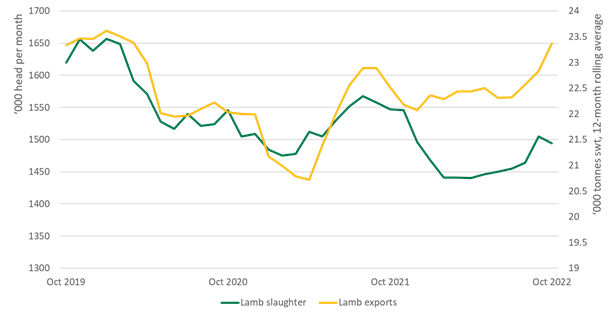Key points:
- Australian red meat exports rose 2% from year-ago levels to 127,706 tonnes in October.
- Beef exports fell 2% from year-ago levels to 72,979 tonnes.
- Lamb exports were 26,144 tonnes, a 33% increase from last year.
Australian red meat exports rose 2% from year-ago levels to 127,706 tonnes in October, driven by high lamb export volumes, as beef exports fell slightly from October 2021 volumes to 72,979 tonnes.
Beef exports
Beef exports fell 2% from year-ago levels to 72,979 tonnes. Exports to Japan fell 16% year-on-year to 15,751 tonnes, making it the largest single market for Australian beef for the month. China and the United States both recorded volume increases of 13% and 1% respectively, and exports to South Korea fell by 11% year-on-year to 13,764 tonnes.
Exports rose in South-East Asia by 25% year-on-year to 9,626 tonnes. Long identified as a key market for Australian beef, the steady increase in exports to South-East Asia has contributed to the increasing diversification of Australian beef export markets.
This was the strongest October for South-East Asian exports since 2019, and volume increases were seen across all major markets: Indonesian exports rose 26%, exports to the Philippines rose 13%, Vietnamese exports rose 57%, and exports to Thailand rose 51%.
All in all, so far in 2022 Australia has exported 708,781 tonnes of beef, 4% less than the first ten months of 2021.
Sheepmeat exports

Lamb exports have risen more quickly than slaughter.
Source: NLRS, DAFF, MLA Calculations
Sheepmeat continued to be exported in large quantities, with large increases in lamb exports compensating for declines in mutton exports. Lamb exports were 26,144 tonnes, a 33% increase from last year. This was the largest export volume seen in October since 2019, when supply was higher, and large increases in exports to the USA and MENA region ensured that chilled lamb exports stayed strong.
The largest shift in lamb exports was South-East Asia, which was the third largest lamb market for the month. Exports to the region more than doubled to 3,798 tonnes, and Papua New Guinea was the largest market in the region, with exports increasing 107% year-on-year to 2,063 tonnes.
Mutton exports were subdued, falling back 7% from October last year but up 6% from September at 13,353 tonnes. A 4% year-on-year increase in exports to China and a 2% increase in exports to South-East Asia partially compensated for a 30% decline in exports to the United States, which remained the second largest mutton market at 2,109 tonnes. The 4% year-on-year increase in exports to China meant that slightly over half of all mutton exports in October went to China, at 6,721 tonnes.
Looking ahead
A weakening Australian dollar is helping to keep Australian red meat competitive in global markets, and both Beef & Lamb NZ and the USDA have forecast declines in production in 2023, meaning that Australian exporters face a positive outlook over the next year, as high sheepmeat production is maintained and as beef production ramps up.






